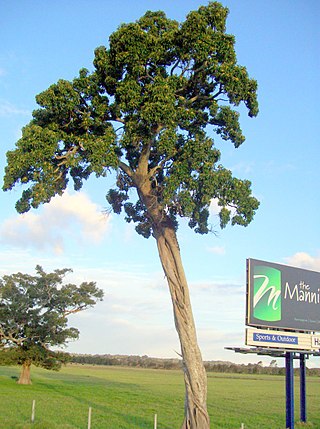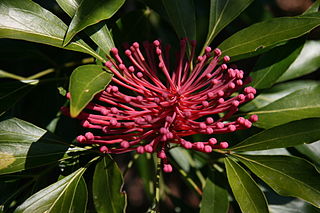
Ficus macrophylla, commonly known as the Moreton Bay fig or Australian banyan, is a large evergreen banyan tree of the Mulberry Family (Moraceae) native to eastern Australia, from the Wide Bay–Burnett region in the north to the Illawarra in New South Wales, as well as Lord Howe Island where the subspecies F. m. columnaris is a banyan form covering 2.5 acres or more of ground. Its common name is derived from Moreton Bay in Queensland, Australia. It is best known for its imposing buttress roots.

Ficus rubiginosa, the rusty fig or Port Jackson fig, is a species of flowering plant native to eastern Australia in the genus Ficus. Beginning as a seedling that grows on other plants (hemiepiphyte) or rocks (lithophyte), F. rubiginosa matures into a tree 30 m (100 ft) high and nearly as wide with a yellow-brown buttressed trunk. The leaves are oval and glossy green and measure from 4 to 19.3 cm long and 1.25 to 13.2 cm wide.

Glochidion is a genus of flowering plants, of the family Phyllanthaceae, known as cheese trees or buttonwood in Australia, and leafflower trees in the scientific literature. It comprises about 300 species, distributed from Madagascar to the Pacific Islands. Glochidion species are used as food plants by the larvae of some Lepidoptera species including Aenetus eximia and Endoclita damor. The Nicobarese people have attested to the medicinal properties found in G. calocarpum, saying that its bark and seed are most effective in curing abdominal disorders associated with amoebiasis.

Eupomatia is a genus of three species of plants in the ancient family Eupomatiaceae, and is the sole genus in the family. Eupomatiaceae is recognised by most taxonomists and classified in the plant order Magnoliales. The three described species are shrubs or small trees, native to the rainforests and humid eucalypt forests of eastern Australia and New Guinea. The type species Eupomatia laurina was described in 1814 by Robert Brown.

Melastoma affine, also known by the common names blue tongue, straits rhododendron or native lassiandra, is a shrub of the family Melastomataceae. Distributed in tropical and sub-tropical forests of India, South-east Asia and Australia, it is a plant of rainforest margins. Bees are the principal pollinators of this species.

Banksia spinulosa, the hairpin banksia, is a species of woody shrub, of the genus Banksia in the family Proteaceae, native to eastern Australia. Widely distributed, it is found as an understorey plant in open dry forest or heathland from Victoria to northern Queensland, generally on sandstone though sometimes also clay soils. It generally grows as a small shrub to 2 metres (7 ft) in height, though can be a straggly tree to 6 metres (20 ft). It has long narrow leaves with inflorescences which can vary considerably in coloration; while the spikes are gold or less commonly yellowish, the emergent styles may be a wide range of colours – from black, purple, red, orange or yellow.

Hibbertia scandens, sometimes known by the common names snake vine, climbing guinea flower and golden guinea vine, is a species of flowering plant in the family Dilleniaceae and is endemic to eastern Australia. It is climber or scrambler with lance-shaped or egg-shaped leaves with the narrower end towards the base, and yellow flowers with more than thirty stamens arranged around between three and seven glabrous carpels.

Correa lawrenceana, commonly known as mountain correa, is a species of shrub or small tree of the family Rutaceae and is endemic to Australia. It has elliptical to egg-shaped leaves arranged in opposite pairs and cylindrical, greenish yellow to red flowers usually arranged singly or in groups of up to seven in leaf axils with the stamens protruding beyond the end of the corolla.

Bursaria spinosa is a small tree or shrub in the family Pittosporaceae. The species occurs mainly in the eastern and southern half of Australia and not in Western Australia or the Northern Territory. Reaching 10 m (35 ft) high, it bears fragrant white flowers at any time of year but particularly in summer. A common understorey shrub of eucalyptus woodland, it colonises disturbed areas and fallow farmland. It is an important food plant for several species of butterflies and moths, particularly those of the genus Paralucia, and native bees.

Ficus obliqua, commonly known as the small-leaved fig, is a tree in the family Moraceae, native to eastern Australia, New Guinea, eastern Indonesia to Sulawesi and islands in the southwestern Pacific Ocean. Previously known for many years as Ficus eugenioides, it is a banyan of the genus Ficus, which contains around 750 species worldwide in warm climates, including the edible fig. Beginning life as a seedling, which grows on other plants (epiphyte) or on rocks (lithophyte), F. obliqua can grow to 60 m (200 ft) high and nearly as wide with a pale grey buttressed trunk, and glossy green leaves.

Planchonella australis, also known by the synonym Pouteria australis, is a medium to tall rainforest tree of the family Sapotaceae native to Queensland and New South Wales, Australia. It is known by the common name black apple, wild plum, yellow buttonwood, black plum and yellow bulletwood.

Breynia oblongifolia, commonly known as coffee bush, grows naturally in Australia and New Guinea as shrubs up to 3 m (10 ft) in height. The species produces alternate, distichous, ovate leaves 20–30 mm (0.8–1.2 in) long by 10–20 mm (0.4–0.8 in) wide. Small, green flowers are produced in spring and summer, and these are followed by orange or pink berries about 6 mm (0.24 in) diameter that turn black when fully ripe.

Glochidion ferdinandi, with common names that include cheese tree, is a species of small to medium–sized trees, constituting part of the plant family Phyllanthaceae. They grow naturally across eastern Australia, from south–eastern New South Wales northwards to northern and inland Queensland, in rainforests and humid eucalypt forests. Frugivorous birds such as pigeons, figbirds and parrots consume its fruit. The tree roots and branches are toxic to dogs, causing liver failure and death.

Myrsine howittiana, the brush muttonwood or muttonwood, is a shrub or small tree in the family Primulaceae. The species is endemic to eastern Australia.

Ficus henneana is a strangler fig only occurring in Australia. Previously considered a variety of Ficus superba which occurs in China, Japan and parts of South East Asia. The cedar fig or deciduous fig grows in Australia from Milton, New South Wales to northern Queensland and the Northern Territory. The habitat is riverine, littoral or the drier forms of rainforest. The fruit is considered edible for humans, but it is not particularly palatable.

Alloxylon pinnatum, known as Dorrigo waratah, is a tree of the family Proteaceae found in warm-temperate rainforest of south-east Queensland and northern New South Wales in eastern Australia. It has shiny green leaves that are either pinnate (lobed) and up to 30 cm (12 in) long, or lanceolate (spear-shaped) and up to 15 cm (5.9 in) long. The prominent pinkish-red flower heads, known as inflorescences, appear in spring and summer; these are made up of 50 to 140 individual flowers arranged in corymb or raceme. These are followed by rectangular woody seed pods, which bear two rows of winged seeds.

Planchonella cotinifolia is an Australian tree in the family Sapotaceae. The common names include small-leaved plum, yellow lemon and small-leaved coondoo. It occurs in the drier rainforests from the Richmond River, New South Wales to the Wenlock River in tropical Queensland.

Clerodendrum floribundum, known as the lolly bush or smooth clerodendrum, is a shrub or tree found in Australia and New Guinea. Its habitat is in or at the margins of coastal rainforests, up to 300 metres above sea level. In Western Australia it grows in drier areas, such as rocky sites, gorges, cliffs, floodplains and creek beds.

Cupaniopsis flagelliformis, commonly known as brown tuckeroo or weeping flower tamarind, is a tree in the lychee, guaraná and maple family Sapindaceae which is endemic to eastern Australia. It is a small tree that inhabits drier or seasonal rainforests.

Glochidion zeylanicum is a species of flowering plant in the family Phyllanthaceae. It is a shrub or tree which ranges from the Indian subcontinent through Indochina, southern China, Taiwan, Japan, Malesia, and Papuasia to northern Australia and Vanuatu.




















